Once upon a time (actually, even now in some bars), you would be ridiculed for using cocktail jiggers behind a bar. There was a stigma that you were either being cheap with your booze or you were just learning how to tend bar.
The idea of creating a consistent drink was never even a consideration for why you would be using a jigger. Either way, using a jigger behind bars was never a good sign for a customer. There is a whole debate about whether to free pour or use a jigger behind the bar, but we will have to save that debate for a later post.
The perception of using jiggers has changed considerably over the last few years, and I would argue they are the most used bartending tools behind craft bars these days.
Weighing in on a Few of the Leading Jiggers on the Market
The Funny Thing About Ounces (oz. vs fl. oz.)
Today, we’re going to check jigger measurements to see how accurate the average jigger actually is. The think about free-pouring or using inaccurate cup markings is that it really throws off your drink recipes!
Note: We did this experiment way back in 2014, and at the time of publish, we weren’t making our own barware yet. Instead of taking down this article, we wanted to update it with our own, actual product.
Seriously, this experiment really affected the way we approached the style of jiggers, measurement markings, and capacity levels. Seeing countless jiggers fail the accuracy test just increased our desire to make the best double jigger ever!

Copyright A Bar Above
OK, back to the experiment.
Ounces are a funny form of measurement and can be difficult to explain. First, ounces can be a measurement of mass– or how much something weighs. Remember that 28 oz. Porterhouse you tried to eat at that steak house?
The other use of ounces is as a measurement of volume, as in the 16 oz. beer that you drink right when you get off of work, or the 2 oz. shot of Fernet you had with it.
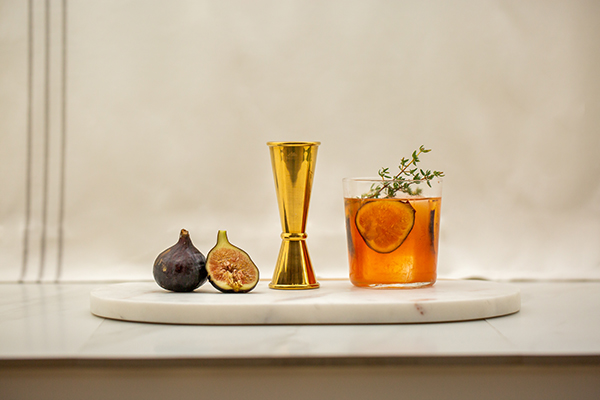
Copyright A Bar Above
What’s even more confusing is that one ounce of liquid (fluid ounce or fl. oz.) is not equal to one ounce (dry ounce or av. oz., meaning avoirdupois oz) on a scale, and different liquids will weigh different amounts given the same volume.
I know, I know. I feel like I’m back in high school chemistry right now. The only conversion that we need to keep in mind when testing out the accuracy of common jiggers is that 1 fl. oz. of water weighs 1.043 oz. on a scale.
FYI, since my scale only goes down to the nearest 0.05 oz, I will be rounding to the nearest 0.05 oz.
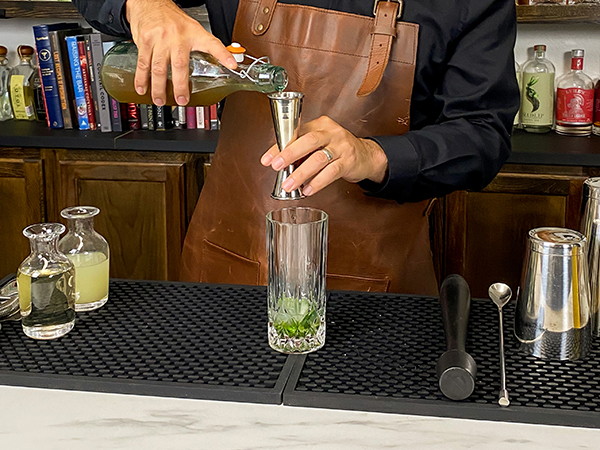
Copyright A Bar Above
Testing our Jiggers
We tested out 4 different jiggers for this post back in 2014, and now we’ve add our A Bar Above jiggers as well; even more importantly, we’ll show you how to test the accuracy of your own jiggers. Even if we tell you which of these jiggers is the most accurate for us, your jigger set can be made with a varying level of accuracy.
I am going to be testing them out under “working conditions,” which means that I won’t be measuring to form a meniscus; I will only fill to the pre-marked line to try to recreate “real life” conditions.
Jigger #1 – Cocktail Kingdom Jigger
This is one of the most popular jiggers in craft bars and, frankly, our biggest competitor, being one of the best-known names on the market.
The tall, slender shape of this conical, two-sided jigger makes it easy to make accurate measures and not have to worry about losing any of the contents over the edge of the jigger.
Sure it’s probably the most visually appealing jigger in our line up, but how does it “measure up?” Sorry for the bad joke, but you should be used to them by now.
- .50 fl. oz.: The line that is etched in the jigger is a perfect measure of the liquid.
- .75 fl. oz.: Once again, a perfect measurement.
- 1.00 fl. oz.: If you pour right to the edge, you have roughly .90 fl. oz. resulting in an under pour or around 10 %.
- 1.50 fl oz – With this jigger, the correct measure is actually well below the marked line. The reading at the pre-marked line equals 1.70 dry weight ounces, or roughly an over-pour of 10% (actual dry ounce weight should be 1.56 fl. oz.).
- 2.00 fl. oz.: Filling up the liquid right to the top, without a meniscus, is a perfect pour for this jigger.
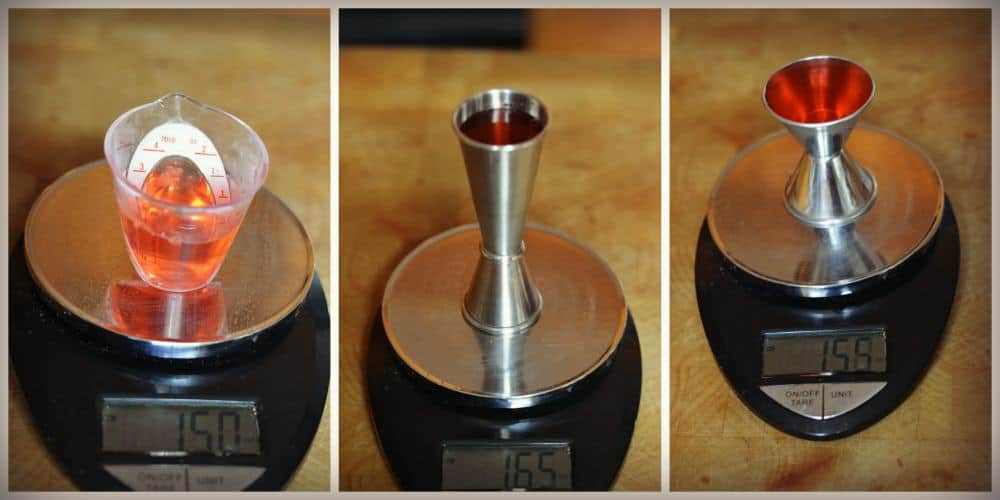
Jigger #2 – OXO
- .25 fl. oz.: This is the lowest measure on this jigger, and filling it right to the line will result in a measure of .20 oz– or an under-pour of 20%.
- .50 fl. oz.: The reading at the line was .40 oz.– once again, a 20% under pour.
- 1.00 fl. oz.: The reading at the 1.00 mark is fairly accurate. It weighs in at 1.00 oz instead of the 1.05 ounce that should be expected. So that’s only a 5% under-pour, which is the closest measure so far with this jigger.
- 1.50 fl. oz.: The reading at this mark is very accurate. It measures in at 1.55 dry weight ounces, which is perfect for this mark.
- 2.00 fl. oz.: The reading at this mark is perfect. It measures 2.10 dry weight oz, which is as close to the “perfect measure” that I can test with my small scale.
Overall, this is a pretty darn accurate mini measuring cup for the larger capacity measurements. The lower capacity markings aren’t super accurate, although having markings from 0.25 ounces to 2 ounces is a cool idea and makes this one the most versatile of the non-A Bar Above jiggers. If only it was accurate all the way throughout!
Jigger #3 – “Conical Jiggers”
- .50 fl. oz.: Filling right up to the edge of the jigger results in a dry weight of .55 dry weight oz., which is a 10% over-pour.
- .75 fl. oz.: Filling right to the edge results in a reading of .65 dry weight oz., or an under-pour of roughly 20%. Big swing in accuracy between the first marking of this cone-shaped jigger and this measurement marking.
- 1.00 fl. oz.: Filling up right to the edge results in a reading of 1.15 av. oz., or an over-pour of 10%.
- 1.50 fl. oz.: Filling right to the edge resulted in a measure of 1.60 av. oz., which is very close to the 1.56 av. oz it should read.
Overall, this double-sided conical jigger is the least accurate. It also has a smaller capacity in terms of sizes of jiggers compared to the other two.
Jigger #4 – Random jigger that should be a .50 oz and a 1.5 oz measure.
This double-ended jigger only has two markings… And it failed on both counts!
- .50 fl. oz.: The actual measure turned out to be .75 av. oz.– a full 50% over!
- 1.5 fl. oz.: The actual measure came in at 1.35 av. oz, or an under-pour of roughly 10-15%.
As you can see, there is variance in each jigger, and I will say that the Cocktail Kingdom jigger did a pretty good job with the least amount of variance across all of its measures.
The biggest thing to look out for is using “promotional jiggers” in a bar program without testing them out for accuracy. With a 50% variance over what the measure should actually be, this will throw off the balance of the drink– and your profit margins.
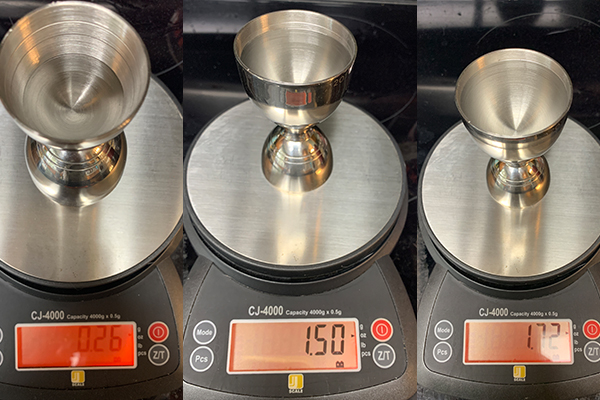
Copyright A Bar Above
Jigger #5: A Bar Above Bell Jigger
OK, now here is our 2023 update, starting with our very own bell jigger– It’s super pretty with its sleek design, but let’s see if it provides accurate amounts of liquid measurements. I’m using a different scale now that accurately measures liquid ounces, so the photos you see have more precise units of measurement than back in 2014.
So yes, there could be some variation in the previous scale; that’s certainly worth noting. But this scale I’m using now is extremely accurate, so you can get a true sense of exactly how precise the A Bar Above alcohol jiggers are.
- .25 fl. oz.: Right at the line, we got a reading of 0.26 ounces.
- .50 fl. oz.: And this reading was perfect at exactly 0.5 ounces right on the line.
- 0.75 fl. oz.: Right on the line, this one measures in at 0.72 ounces.
- 1.00 fl. oz., smaller side: All the way to the top without flowing over, our bell jigger is exactly 1 ounce.
- 1.00 fl. oz., larger side: This line measured as 1.08 oz.
- 1.25 fl. oz: At 1.24 oz, this line is pretty darn close to perfect.
- 1.50 fl. oz.: This measurement was right on the line and weighed in at exactly 1.5 ounces.
- 1.75 fl. oz: Measuring right at the bottom of the line, this marking measured out as 1.72 ounces.
- 2.00 fl. oz.: Filled all the way to the top, our older model bell jigger measured 2.10 ounces, about 10% over when filled all the way to the top without flowing over.
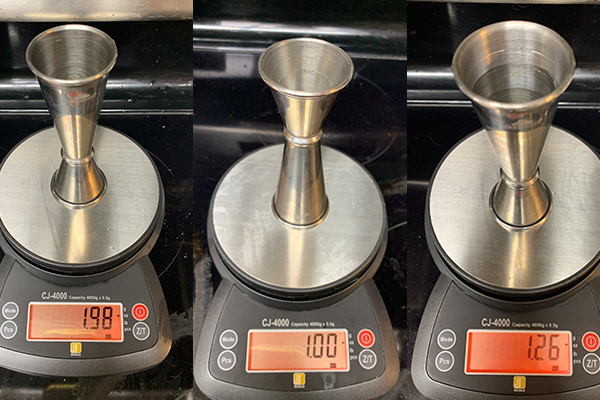
Copyright A Bar Above
Jigger #6: A Bar Above Japanese Jigger
And to round out the experiment, I’m finishing with our stainless steel Japanese jigger.
While I’m obviously biased, the numbers speak for themselves; in terms of consistent accuracy, our A Bar Above bartender jigger is simply the most exact with liquid ingredients out of all the ones we’ve looked at. Worth noting that this one has markings from 0.25 up to 2 ounces like the OXO jigger (but with more precision), unlike most traditional jiggers.
And while I’m working with an older prototype, our current version of both styles of jiggers include a bar spoon measurement (1/8 ounce) and a 1.75 oz marking– not something you find on a standard jigger! In fact, none of the other jiggers we’ve looked at have that versatility.
- .25 fl. oz.: At 0.24 oz and just shy of the line, this pour is almost perfect.
- .50 fl. oz.: Although I went just slightly over the line, this one weighed in at exactly a 1/2 ounce. Right at the line is about 0.48 oz.
- 0.75 fl. oz: Measuring in at 0.74 oz, this one is again nearly exact.
- 1.00 fl. oz., smaller side: Measured it at 1.04 oz when filled up all the way to the brim. When I tried again and filled it up without flowing onto the brim, it was exactly. 1 ounce.
- 1.00 fl. oz, larger side: Weighing in at 1.02 oz, although it looks like I poured it just slightly above the line.
- 1.25 fl. oz: Again, looking like I went just over the line, this measurement weighed in at 1.26 oz.
- 1.50 fl. oz.: My first pour was 1.58 oz, which is over by about 8%, although I was a bit over the line yet again. When I tried again, the weight was 1.48 oz. Either way, the margins are pretty darn good.
- 2.00 fl. oz.: This one weighed in at 1.98 oz, stopping just before the top rim, a nearly perfect measurement.
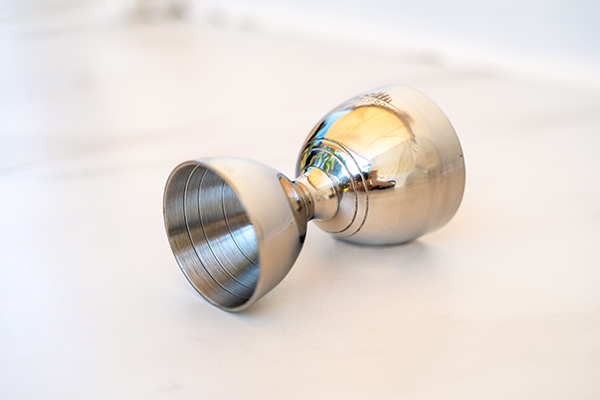
Copyright A Bar Above
So if you want the perfect balance of a touch of class and precise measuring amounts in your bartender kit, definitely grab our stainless steel Japanese style jigger. Notice that our measuring cups also have lines at every 1/4 ounce, making them the most versatile on the market and guaranteeing them to be your new favorite jigger.
Whether you’re a professional bartender or just like making perfect cocktail recipes at home, clearly the type of jigger you use matters!
So have you tested out your jiggers? Do you have a favorite that you use behind your bar? Leave us a comment with your results. And if you don’t have a jigger or just realized that your current one isn’t measuring up (quite literally), make sure to add ours to your bartending kit!




Chris, was the Cocktail Kingdom jigger you tested one of their Japanese Style jiggers?
Yeah it was the 2 oz jigger they sell. It’s a beautiful piece of equipment
I used to check for consistency between my jigger, if two half ounces would measure a whole once and things like that. Thats an easy way to check for proportions consistency only, though. The scale method is very good! Great video, it really can be a leak of money on those jiggers.
Yeah, for the most part the jiggers were only off by about 10%, but there were a few that were considerably off their mark.
Thanks Thiago,
I was very shocked to see that the promotional jigger was off by 50%. That will cut into your margins real quick
Can you rope in some self-professed free pouring gurus to see how well they can do against a jigger?
I like this idea Frederic. Going to give you credit on this one if it works out 🙂
I’d love to see this kind of test repeated for different brands of pour spouts. The high volume bar I used to work at pour tested the bartenders weekly on their free pours. We had to nail 40 out of 45 pours; 20 right hand 20 left hand and 5 margarita pours. The test bottles had SS 285-50 but the rest of the bar was a total grab bag of pour spouts. The lack of consistency drove me up the wall. Anyway I really enjoy your blog and have listened to every podcast Keep up the good work.
This is a pretty old comment thread I’m reviving, and I haven’t been though enough of the sites content to know whether this has already been done in another post, but I’d like to throw my hat in. Outside of a job interview, there’s almost no skill or talent that I feel or suspect I may have that I wouldn’t downplay in conversation, at least mildly. My free pouring, however, is the exception only because I was genuinely amazed at the consistency of the perfect pours I watched my hands pour while testing myself after a few weeks of diligent practice.
But I’m basically certain that it isnt due to any sort of physical ability or special gene that I have. I just kind of had a weird approach towards free pouring from the start. I’ve always thought it odd when numerous blogs will give a basic description of counting to 4 while pouring in posts titled ‘LEARN HOW TO FREE POUR’ as if it were ever any sort of mystery. Humans pretty much always use a strategy that centers around counting when attempting to perform consistent steady movements at a constant pace for a length of time. Music, CPR, dancing, marching, etc. Which is why 4 counts has always seemed like an awful number to go with in my opinion. The idea behind counting is to regulate your minds subjective sense of the passage of time. It’s really a very complicated neurological task. We aren’t very good at it, and I’ve listened to dozens of drumming instructors y’all about how to deal with that. It’s actually a common trick that all sorts of music instructors know, which is to subdivide the pulse while you play music. You double the number of pulses. That’s where the human error is. Also, 4 counts isn’t a great mathematical choice either. I mean it has a prime factorization of two, which means it’s basically impossible
to count out ounces in thirds consistently and reliably. These reason combined are why I pour using 12 counts for each ounce. At this rate, if I were speaking clearly, I would be counting about as fast as I can comfortably count aloud. Nice solid way to make sure you’ve got your rhythm calibrate right anytime you feel like checking. I practice this in all different combinations of ways with various numbers of bottles, and testing my results by measuring out each pour with a variety of odd fractions using 3 separate jiggers. 6 counts, 2 bottles, 1 hand = 1oz, 18 counts of bottle A during which I pour bottle B with other hand for first 6 counts, then swap to bottle C which I pour for last 6 counts = 2.5 oz, etc. That type of shit. Anyway, I can make a vid or something
I for one am happy to see the OXO jigger is under on the 1/4 oz mark because I always seem to go over on that puny pour 🙂
Agreed Josh, it’s almost impossible to make an accurate 1/4 oz pour on those jiggers, especially in a dark bar
I have had the most success in pouring an accurate 1/4 oz. for years by free pouring it. If you are using a spill stopper 285-50 and are aggressively getting your bottles to 1 o’clock (right hand) or 11 o’clock (left hand) you will get a bubble, the pour spout is designed to put out an exact quarter ounce when you get that “bubble” . After you get that first quarter ounce the flow stops and starts again.
Lol and I’m assuming you measured this?
Yes of course lol, and it comes out exact every time (its all about the technique and the right pour spout as stated above), I have been coaching this technique on a global scale since the late 90’s with nothing but success…measure it in an exacto pour or by scale see for yourself 😉
Lol its still not as accurate as you portray. Basically if you’re doing bartending where accuracy matters like i do you use a jigger, period. If you don’t then you’re doing what I would refer to as dive bar bartending, where I wouldn’t even know where you’re using 1/4oz pours. Maybe in that raspberry liqueur you’re adding to your lemon drop? But when you’re making craft cocktails and using ingredients like amari, fernet and mezcal the difference between a 1/4oz and 1/2oz will drastically change your cocktail and we don’t rely on something as ridiculous as an air bubble to measure our pours for us.
I figured you were going to start insulting as I have seen your other posts, thats not what this site is for (Chris back me up here) Yes it is if trained and practiced properly it is very accurate with spirits with a viscosity close to water and yes the spirits would be room temp. I never implied it worked for all spirits….But the dive bar comment….no I dont work in a dive bar (although I do love a good dive bar) so do you know what the World Class competition? The bartender from France won it with bubble pouring (I will let you look up the list of judges) ever heard of broken shaker or sweet liberty in miami? ( made the worlds top 50 bars) they also bubble pour/ free pour on a lot of their cocktails. I have been doing this and training people to do this for decades, I am also a three time national accuracy champion….it does work….open your mind man…there isnt one way to do eveything, although I know a jigger is a necessity in a good amount measurements for diff ingredients as well …..do you even know how to free pour? If you are doing it with proper technique you will get a bubble (I guessing you have no idea about this?)…this is for base spirits mostly….but I can also do it with fernet if not refrigerated….you posted a reply two years later….most of your posts are negative….its a community not a competition to see who can shut who down….This was about ways to pour a 1/4 oz. accurately and I simply offered what had worked for me and 1000’s of others…
Chris, awesome video. Honestly never even came to mind that there could be a chance a “measuring device” could be inaccurate. Consistency is key. I love the Japanese style 2oz/1oz jiggers also the .75/.5 from cocktail kingdom. Just love the whole look and style of them and it’s a bonus to know they were the most accurate. Trying to convince the wife to get me the gold plated ones for Christmas :-p Beautiful but unnecessary lol. Also what your doing for the beverage community is amazing. Can’t thank you anymore for all your knowledge and inspiration. I’ve become a more confident bartender/liquor enthusiast since I’ve came across your website. Also I’m gonna be signing up for your cocktail design course shortly here. Wifey have me green light but only after finish my master brewing course I found on groupon lol
Great to hear Terry, and I hope you get those gold plated jiggers for Christmas 🙂 I’d love to hear about how your beer class goes when you’re done with it.